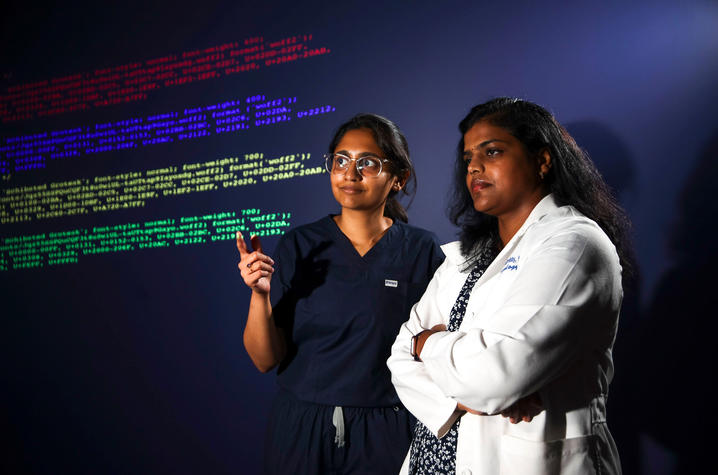No patient left behind: Virtual escape room changes the game in neurology education at UK
LEXINGTON, Ky. (July 21, 2025) - Imagine learning how to diagnose and treat a stroke not in a lecture hall, but by solving puzzles under pressure — clicking through clues, reviewing CT scans, decoding crossword-style clinical findings — all while the clock ticks down.
That’s exactly the experience Rani Priyanka Vasireddy, M.D., a movement disorders fellow and instructor in the University of Kentucky College of Medicine’s Department of Neurology, has brought to life with a first-of-its-kind virtual neurology-themed escape room. Vasireddy along with Dhanya Gorty, M.D., an incoming UK neurology resident, developed the program to make medical education more engaging, interactive and fun. This innovative tool is already making waves in academic medicine.
“We’re neurologists — we love solving puzzles,” said Vasireddy. “So we asked ourselves, why can’t learning neurology feel like solving one? That’s how the escape room idea was born.”
The project was recently showcased at the American Academy of Neurology’s annual meeting, where participants got a sneak peek into the game’s inaugural case: a simulated stroke alert scenario, where learners must gather information, assess symptoms and act quickly to “save the patient” — virtually, of course.
A game with a purpose
Unlike traditional simulations, where students respond to scripted patient scenarios in a lab setting, this digital escape room uses interactive elements and real-time feedback to guide learners through complex clinical reasoning.
“Instead of giving them the case upfront, they find the case,” said Vasireddy. “Every action leads to a clue — clicking on the patient’s face might reveal facial droop, while clicking on the leg may show weakness. It’s immersive and mimics real clinical thinking.”
The virtual design also overcomes a key limitation of physical escape rooms: space.
“We didn’t need a real room, mannequins or actors. My coding skills and health care IT background made it possible to build the experience online,” said Vasireddy, who developed the game using a cost-efficient platform after extensive research.
But the game is not just about fun — it’s rooted in serious training. The creators used the Kern’s six-step approach to curriculum development and Bloom’s Taxonomy to ensure the experience delivers educational value at multiple levels.
“At the most basic level, learners recall and understand medical knowledge,” said Vasireddy. “Then, they apply and analyze that knowledge to solve each challenge, building toward the ultimate goal: an accurate diagnosis and timely intervention.”
Teaching by doing — and failing forward
Failure is built into the experience — but in a way that promotes growth rather than discouragement.
“We originally considered letting the patient ‘die’ if the wrong choice was made, but we realized that could hurt morale,” said Vasireddy. “Instead, we built in live feedback. If learners take a wrong turn, the game tells them what went wrong and offers a chance to try again.”
This approach fosters a growth mindset, allowing participants to learn from mistakes without fear of judgment — something Gorty, who co-developed the project, calls “edutainment.”
“It’s the perfect blend of education and entertainment,” said Gorty. “And it works across training levels — from medical students to residents — because the challenge is in the process, not just the content.”
Looking ahead
Vasireddy hopes the escape room model can be adapted for a variety of topics and specialties and even be used as a teaching tool by other institutions. The team plans to provide participants with the materials and framework to create their own games, encouraging a new generation of educators to embrace innovation.
“Creating something like this isn’t easy,” she admitted. “The hardest part wasn’t the coding — it was building an experience that’s educational, engaging and linear, so learners don’t lose track of the objective. That takes time, testing and a lot of iteration.”
Still, the payoff is worth it.
“In the end, we’re not just teaching facts — we’re teaching how to think like a neurologist,” Vasireddy said. “And if we can do that in a way that’s fun, memorable, and maybe even a little thrilling? That’s a win.”
UK HealthCare is the hospitals and clinics of the University of Kentucky. But it is so much more. It is more than 10,000 dedicated health care professionals committed to providing advanced subspecialty care for the most critically injured and ill patients from the Commonwealth and beyond. It also is the home of the state’s only National Cancer Institute (NCI)-designated Comprehensive Cancer Center, a Level IV Neonatal Intensive Care Unit that cares for the tiniest and sickest newborns and the region’s only Level 1 trauma center.
As an academic research institution, we are continuously pursuing the next generation of cures, treatments, protocols and policies. Our discoveries have the potential to change what’s medically possible within our lifetimes. Our educators and thought leaders are transforming the health care landscape as our six health professions colleges teach the next generation of doctors, nurses, pharmacists and other health care professionals, spreading the highest standards of care. UK HealthCare is the power of advanced medicine committed to creating a healthier Kentucky, now and for generations to come.





